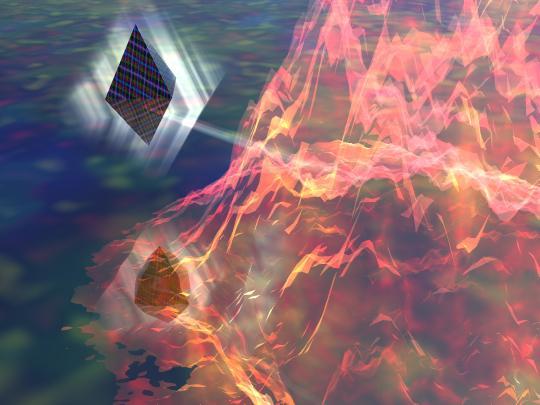BY LETTER
Inorganic Chemistry
 Image from Keith Wigdor |
Inorganic chemistry is the branch of chemistry that deals with all elements and compounds except for the hydrocarbons and their derivatives. It includes the studies of ceramics, extreme temperatures and pressures, geochemistry, metals and metallurgy, inorganic mineralogy, quantum chemistry, and solid-state physics, and studies of the nature and behaviour of exotic artificial elements. Advanced inorganic chemistry is one of the foundations of inorganic, or "dry" nanotechnology.
Articles
- Alloy - Text by M. Alan Kazlev
A metallic element modified by the addition of one or more other elements ('dumb' alloy) or by the addition of nanotech devices ('smart' alloy). - Ammonia - Text by M. Alan Kazlev
A colourless, pungent, corrosive gas, NH3, extensively used in the manufacture of crude organobiota and a wide variety of nitrogen-containing organic and inorganic products and chemicals. In is an important component in the atmosphere of some Jovian planets. - Atom - Text by M. Alan Kazlev
The smallest particle of an element that retains the chemical properties of an element. - Atomic Mass Unit - Text by Stephen Inniss
Also called a.m.u. and dalton, and designated with the symbol "u". A unit of mass equal to 1/12 the mass of an unbound carbon-12 nucleus that is at rest and in its ground state. - Carbon - Text by Steve Bowers
Non-metallic element with symbol C. - Hylonano - Text by Todd Drashner
Molecular Nanotechnology (dry nanotech). Use of artificially created non-biomolecular systems as replicators, assemblers, or components of molecular nanotechnology; any molecular nanotechnology not based on bio-molecules or biotech. Sometimes referred to as "Drexlerian nanotech". - Iron - Text by M. Alan Kazlev
Metallic chemical element; symbol Fe atomic number 26; (group VIII of the periodic table). Unlike lighter elements, iron cannot be fused to yield energy, and unlike heavier elements it does not yield energy on fission. It exists in four distinct natural crystalline forms. It is a good conductor of heat and electricity. White dwarfs consist almost entirely of iron. Iron is a component of hemoglobin, the oxygen-carrying pigment of the red blood cells of terragen vertebrates.
Development Notes
Text by M. Alan Kazlev; modified by Stephen Inniss
Initially published on 10 November 2001.
Initially published on 10 November 2001.
Additional Information






